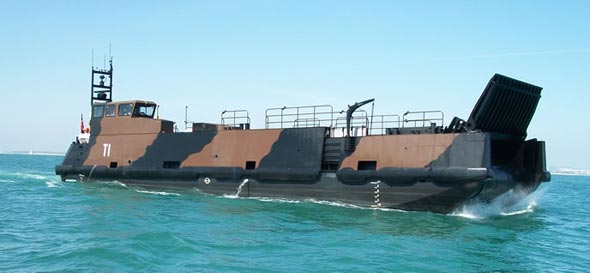An innovative high speed landing craft soon to be tested by the British MOD will enable the Navy to explore the feasibility of operating a hybrid vessel combining air cushion and CATamaran hull offering landing crafts higher speed, heavier loads and better seakeeping. Known as ‘Partial Air Cushion Supported CATamaran (PACSCAT), the new vessel was developed by QinetiQ as an Innovative Solution Demonstrator Craft (ISDC).

The Navy requires fast landing crafts to off-load front line vehicles from Royal Navy amphibious ships to the beach. The ISDC is designed to test at full scale the hydrodynamics of the PACSCAT hull form, originated by John Lewthwaite of Independent Maritime Assessment Associates Ltd., and to investigate its feasibility to deliver significantly faster speeds than traditional landing craft.
QinetiQ is working on the PACSCAT design since 2007 as it was selected as the prime contractor for the ISDC. The company has been working alongside hovercraft specialist Griffon Hoverwork Ltd at their base in Hythe in Southampton. The aluminium hull was constructed by Aluminium Shipbuilders Ltd. The experimental vessel has recently completed over 100 hours at sea, in contractor evaluation sea trials, gradually reaching unloaded speeds exceeding 30 kts in Sea State 2.
The high speed, all aluminium PACSCAT ISDC vessel is 30m long, 7.7m in the beam, has a design vehicle payload of 55 tonnes and an approximate loaded weight of 175 tonnes. It is propelled by twin MJP water jets, driven by Diesel engines manufactured by MTU.
Testing is scheduled to undergo evaluation trials through the end of 2010 at the Royal Marines facilities at Instow, Devon. As part of these tests the ISDC will perform a variety of roles focused on the potential advantages of low and variable draught (for example in situations where high speed and high payload capacities are required in conjunction with exceptional beaching qualities.) On completion of trials and as part of the Fast Landing Craft Concept Phase, the MOD will conduct a cost and performance-based appraisal of this solution with other options determined in the MOD Fast Landing Craft Design Solutions Study.
















